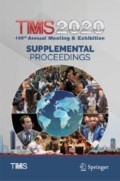Abstract
This study investigates the influence of different scanning strategies on the hardness of the parts, fabricated by direct metal laser melting . In this work, pre-alloyed powder of titanium alloy (Ti–6Al–4V) is used to produce dense parts with three different scanning strategies: unidirectional, alternate, and cross-hatching. A numerical scheme is developed to predict the heat transfer , fluid flow, and thermal history -based phase transformation during the process. Surface hardness is calculated from the obtained phase fractions. Hardness is measured experimentally, and X-ray diffraction is used for phase identification. The hardness is found to be highly dependent on the microstructure of as-built parts. The results show that rapid solidification during direct metal laser melting leads to the formation of hcp-structured acicular martensite from the parent beta phase, which increases the hardness . Higher part densities are observed for cross-hatching strategy compared to other scanning strategies. The predicted maximum hardness for different scanning strategies compare well against the experimental observations.
Access this chapter
Tax calculation will be finalised at checkout
Purchases are for personal use only
References
Kumar S (2003) Selective laser sintering: a qualitative and objective approach. JOM 55(10):43–47
Khaing MW, Fuh JYH, Lu L (2001) Direct metal laser sintering for rapid tooling: processing and characterization of EOS parts. J Mater Process Technol 113:269–272
King D, Tansey T (2002) Alternative materials for rapid tooling. J Mater Process Technol 121:313–317
Gibson I, Rosen DW, Stucker B (2010) Additive manufacturing technologies—rapid prototyping to direct digital manufacturing. Springer Science + Business Media, LLC, New York, NY
Dahotre NB, Harimkar SP (2008) Laser fabrication and machining of materials. Springer Science + Business Media, LLC, New York, NY
Mellor S, Hao L, Zhang D (2014) Additive manufacturing: a framework for implementation. Int J Prod Econ 149:194–201
Ruffo M, Hague RJM (2007) Cost estimation for rapid manufacturing—simultaneous production of mixed components using laser sintering. Proc Inst Mech Eng, Part B: J Eng Manuf 221(11):1585–1591
Atkinson D (1997) Rapid prototyping and tooling, a practical guide. Strategy Publication Ltd., Welwyn Garden City, UK
Hänninen J (2001) DMLS moves from rapid tooling to rapid manufacturing. Met Powder Rep 56(9):24–29
Steen WM, Mazumder J (2010) Laser material processing, 4th edn. Springer-Verlag London Limited, London, UK
Hopkinson N, Hague R, Dickens P (2006) Rapid manufacturing: an industrial revolution for the digital age. John Wiley & Sons, Chichester, UK
Farshidianfar MH, Khajepour A, Gerlich AP (2016) Effect of real-time cooling rate on microstructure in laser additive manufacturing. J Mater Process Technol 231:468–478
Bidare P et al (2018) Fluid and particle dynamics in laser powder bed fusion. Acta Mater 142:107–120
Qiu C et al (2015) On the role of melt flow into the surface structure and porosity development during selective laser melting. Acta Mater 96:72–79
Murr LE et al (2009) Microstructure and mechanical behavior of Ti–6Al–4V produced by rapid-layer manufacturing, for biomedical applications. J Mech Behav Biomed Mater 2(1):20–32
Thijs L et al (2010) A study of the microstructural evolution during selective laser melting of Ti–6Al–4V. Acta Mater 58.9:3303–3312
Chlebus E et al (2011) Microstructure and mechanical behaviour of Ti–6Al–7Nb alloy produced by selective laser melting. Mater Charact 62.5:488–495
Voller VR, Swaminathan CR (1991) ERAL Source-based method for solidification phase change. Numer Heat Transfer, Part B Fundam 19.2:175–189
Mills KC (2002) Recommended values of thermophysical properties for selected commercial alloys. Woodhead Publishing
Welsch G, Boyer R, Collings EW (eds) (1993) Materials properties handbook: titanium alloys. ASM international
Lips T, Fritsche B (2005) A comparison of commonly used re-entry analysis tools. Acta Astronaut 57(2-8):312–323
Kelly SM (2004) Thermal and microstructure modeling of metal deposition processes with application to Ti–6Al–4V. Ph.D. thesis. https://theses.lib.vt.edu/theses/available/etd-11242004-211009/
Charles C, Järvstråt N (2009) Modelling Ti–6Al–4V microstructure by evolution laws implemented as finite element subroutines: application to TIG metal deposition. In: David SA et al (eds) Proceedings of the 8th international conference on trends in welding research (TWR), Pine Mountain, Georgia (USA), pp 477–485
Murgau CC, Pederson R, Lindgren LE (2012) A model for Ti–6Al–4V microstructure evolution for arbitrary temperature changes. Model Simul Mater Sci Eng 20(5). https://doi.org/10.1088/0965-0393/20/5/055006
Irwin J, Reutzel ET, Michaleris P, Keist J, Nassar AR (2016) Predicting microstructure from thermal history during additive manufacturing for Ti–6Al–4V. J Manufact Sci Eng 138. https://doi.org/10.1115/1.4033525
Hahn JD, Shin YC, Krane MJM (2007) Laser transformation hardening of Ti–6Al–4V in solid state with accompanying kinetic model. Surf Eng 23(2):78–82
Hollander DA, von Walter M, Wirtz T, Sellei R, Schmidt-Rohlfing B, Paar O et al (2006) Biomater 27(7):955–963
Rombouts M (2006) PhD thesis. KU Leuven
Dinda GP, Dasgupta AK, Mazumder J (2009) Laser aided direct metal deposition of Inconel 625 superalloy: microstructural evolution and thermal stability. Mater Sci Eng, A 509(1-2):98–104
Author information
Authors and Affiliations
Corresponding author
Editor information
Editors and Affiliations
Rights and permissions
Copyright information
© 2020 The Minerals, Metals & Materials Society
About this paper
Cite this paper
Ghate, N.D., Gaur, B., Shrivastava, A. (2020). Effect of Scanning Strategy on Additively Manufactured Ti6Al4V. In: TMS 2020 149th Annual Meeting & Exhibition Supplemental Proceedings. The Minerals, Metals & Materials Series. Springer, Cham. https://doi.org/10.1007/978-3-030-36296-6_33
Download citation
DOI: https://doi.org/10.1007/978-3-030-36296-6_33
Published:
Publisher Name: Springer, Cham
Print ISBN: 978-3-030-36295-9
Online ISBN: 978-3-030-36296-6
eBook Packages: Chemistry and Materials ScienceChemistry and Material Science (R0)

